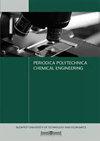质子交换膜燃料电池:聚焦于有机-无机纳米复合膜
IF 1.8
4区 工程技术
Q3 ENGINEERING, CHEMICAL
引用次数: 0
摘要
有机-无机纳米复合膜的应用允许无机材料的理想热学和机械性能与聚合物材料的反应性、介电性能、耐久性、柔韧性和可加工性之间的协同作用。质子交换膜燃料电池(pemfc)存在一些问题,包括水含量管理、一氧化碳中毒、氢重整和燃料通过膜的交叉。本文针对上述问题提出了有机-无机纳米复合材料的具体解决方案。这些解决方案包括在质子交换膜中掺杂质子导电无机纳米粒子、溶胶-凝胶法制备纳米复合材料、无机化合物与聚合物结构的共价键、酸基质子交换纳米复合膜。此外,还对乙醇蒸汽重整法低一氧化碳制氢以及CO在PEMFC进料中的作用进行了解释和讨论。最后,讨论了在交换膜细胞(emfc)中实现最大功率密度的理想条件。本文章由计算机程序翻译,如有差异,请以英文原文为准。
Proton Exchange Membrane Fuel Cells: Focused on Organic-Inorganic Nanocomposite Membranes
The application of organic-inorganic nanocomposite membranes allows for a synergy between the desirable thermal and mechanical properties of inorganic materials with the reactivity, dielectric properties, durability, flexibility, and processability of the polymeric materials. Proton exchange membrane fuel cells (PEMFCs) suffer from some problems including water content management, carbon monoxide poisoning, hydrogen reformate, and fuel crossover through the membrane. Herein, specific solutions have been proposed to the above-mentioned problems using organ-inorganic nanocomposites. These solutions include doping proton conductive inorganic nano-particles in the proton exchange membrane, preparing nanocomposites via the sol-gel method, covalence bond of inorganic compounds with the polymer structure, and acid-based proton exchange nanocomposite membranes. Furthermore, hydrogen production with low carbon monoxide content using the ethanol steam reforming method, as well as the effect of CO in the hydrogen feed of PEMFC are explained and discussed. Finally, desirable conditions for achieving the maximum power density in exchange membrane cells (EMFCs) are discussed.
求助全文
通过发布文献求助,成功后即可免费获取论文全文。
去求助
来源期刊

Periodica Polytechnica Chemical Engineering
ENGINEERING, CHEMICAL-
CiteScore
3.10
自引率
7.70%
发文量
44
审稿时长
>12 weeks
期刊介绍:
The main scope of the journal is to publish original research articles in the wide field of chemical engineering including environmental and bioengineering.
 求助内容:
求助内容: 应助结果提醒方式:
应助结果提醒方式:


